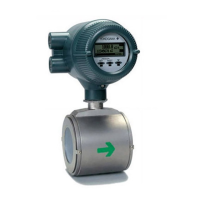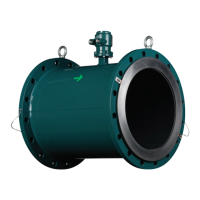3.3.4 Nominal Diameter 2.5 mm (0.1 in.) to
400 mm (16 in.), Flange Type
IMPORTANT
Useboltsandnutsincompliancewiththeange
ratings. Be sure to choose a gasket with inner and
outer diameters that does not protrude inside the
piping (refer to Table 3.3.16). If the inner diameter of
the gasket is too large, or outer diameter of the gasket
istoosmall,uidleakagemayresult.
(1) Mounting Direction
Mounttheowmetersothattheowdirectionoftheuid
to be measured is in line with the direction of the arrow
markontheowmeter.
IMPORTANT
If it is impossible to match the direction of the arrow
mark, the direction of the electrical connection can
be changed. Refer to the applicable user’s manuals
which can be downloaded from our website.
Incasetheuidbeingmeasuredowsagainstthe
arrowdirection,changethevaluefrom“Forward”to
“Reverse”attheparameter[J20:FlowDirection]
(refer to Chapter 8).
(2) Tightening Nuts
Tighten the bolts according to the torque values for the
metal piping in Table 3.3.13. For PVC piping, select an
optional code of GA, GC, or GD, use rubber gaskets and
tighten the nuts to the torque values for the PVC piping in
Table 3.3.14.
Forpermeableuids(suchasnitricacid,hydrouoric
acid, or sodium hydrate at high temperatures), tighten the
nuts according to the torque values in Table 3.3.15.
CAUTION
ForaowmeterwithuorocarbonPFAlining,itis
possible that the nuts may loosen as time passes,
so tighten them regularly. Be sure to tighten the nuts
according to the prescribed torque values. Tighten
them diagonally with the same torque values, step by
step up to the prescribed torque value.
*Gasket (two units)
*Piping-side flange
*Bolt
(eight units)
Flowmeter-side flange

